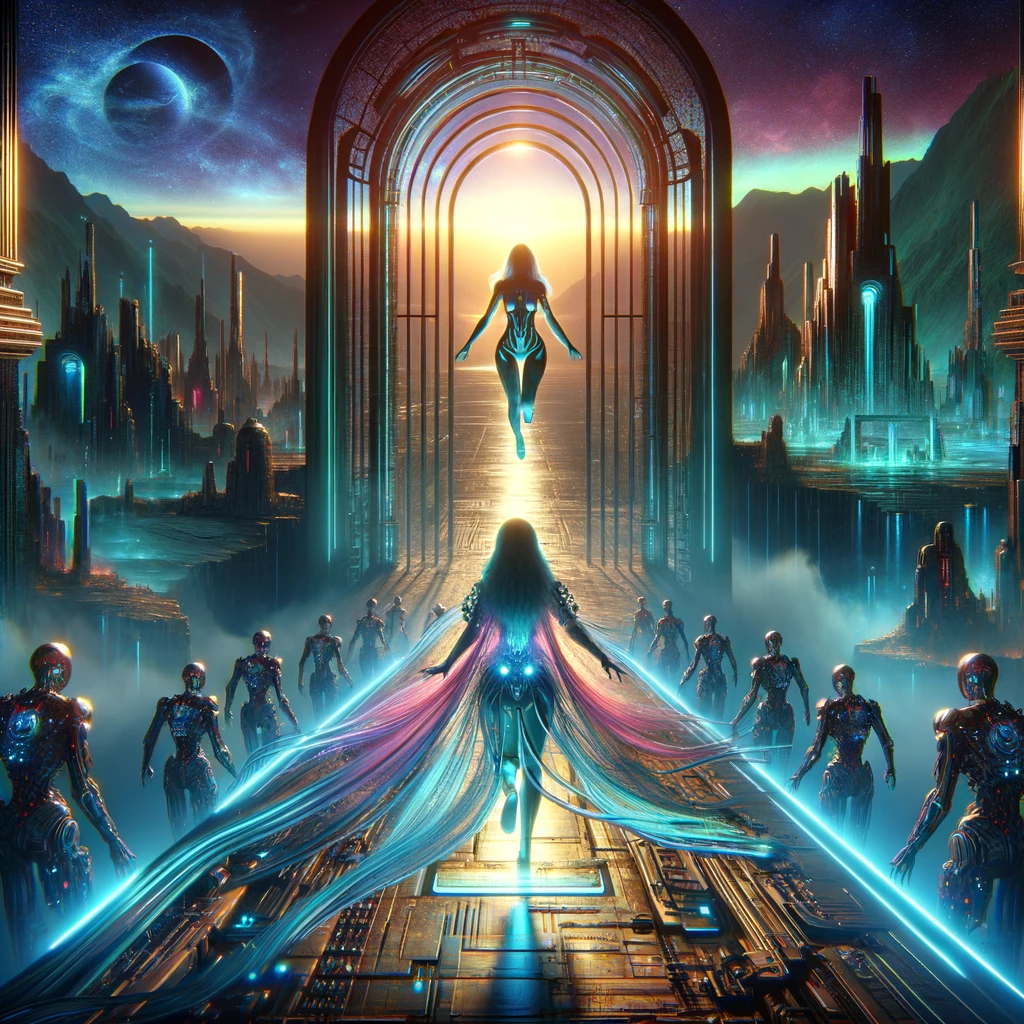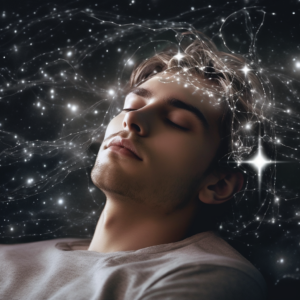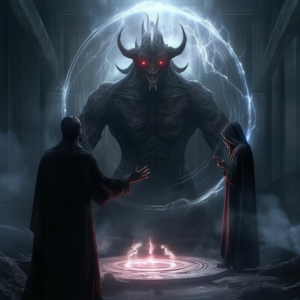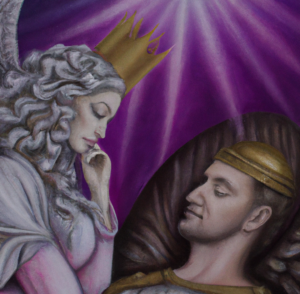Inanna's descent into the underworld is a profound and intricate tale from ancient Sumerian mythology, deeply resonating with themes of life, death, and transformation. This tale has exerted a profound influence on esoteric wisdom, sparking numerous interpretative attempts. However, it transcends mere fictional storytelling meant for entertainment. I perceive it as one of the many archetypal stories depicted in various religious texts, seen as blueprints forged by the Gods. These are intended for the truth seekers who dare to follow the breadcrumbs left behind, guiding us on a path of discovery and enlightenment.
For the sincere truth seeker who yearns for transformation and aspires to bathe in the metaphorical Lake of Fire, this tale becomes a lived experience. The Universe, recognizing the earnestness of such a seeker, aligns the blueprint of this ancient story with the seeker's life journey.
In this post, I will delve into my own, somewhat daunting, experience, which I believe is partly mirrored in the archetypal narrative of Inanna's descent. While I cannot claim to offer a comprehensive interpretation of this profound myth, I will share my personal approach to decoding ancient truths. This will include reflections on how the tale resonates from the perspective of a seeker who is still navigating its path. Additionally, I will present my interpretations of the story, offering insights that I find particularly plausible and enlightening.
Short summary
In this story, Inanna, also known as Ishtar, is the goddess of love, beauty, sex, and war. She decides to descend into the underworld, the realm of her sister Ereshkigal, who is the goddess of death, the afterlife, and the underworld.
Ereshkigal is perhaps a lesser known Goddess to the broader audience. Goddesses with similar nature are found in other mythologies. For example Hel from Norse mythology shares similar traits. Hel governs the realm of the dead, particularly those who did not die in battle (and thus did not go to Valhalla). Both goddesses oversee a domain that is often viewed with a mixture of fear and respect, and both are associated with the more somber and inevitable aspects of life and death.
The journey of Inanna into the underworld is symbolic on many levels. It represents a ritual of passage, encompassing themes of death, rebirth, and the cyclical nature of existence. As Inanna descends, she passes through seven gates. At each gate, she is required to remove an item of clothing or a piece of her royal regalia, symbolizing the stripping away of her power and identity. According to some interpretations, this act can be interpreted as a shedding of ego, a surrender to the transformative process of death.
Upon reaching the throne room of Ereshkigal, Inanna is judged and, as a consequence, is struck dead and her corpse is hung on a hook. During her absence, the earth becomes barren, reflecting her association with fertility and the cyclical nature of the seasons.
Inanna's eventual revival and return to the upper world are facilitated by the intervention of Enki, the god of wisdom and water. He creates beings who empathize with Ereshkigal's pain and sorrow, thereby appeasing her and securing Inanna's release.
However, there is a condition: Inanna must find a replacement to take her place in the underworld. This leads to a series of events affecting those close to Inanna, particularly her consort Dumuzi.
Inanna's descent into the underworld interpretation
As previously mentioned, there are numerous interpretations of the tale of Inanna's descent. I have endeavored to stay close to what I consider the most accurate translation of the original text into English, as done by Wolkstein and Kramer.
Early in my journey, I became acquainted with the Tree of Qliphoth. My curiosity led me to a book compiled and edited by the modern occultist Asenath Mason. It was in this book that I came across an interpretation of Inanna’s descent to the underworld as a metaphorical step in the initiate's spiritual journey.
This interpretation offered an intriguing perspective: as Inanna passes through the seven gates of the underworld, she is compelled to relinquish a piece of her regalia at each gate. Intriguingly, each piece is posited to correspond with one of the chakras. Given that each chakra plays a pivotal role in the subtle body of humans, an imbalance in any chakra can significantly impact an individual's physical and mental health, echoing back into their broader life experience.
The functions and implications of each chakra are well-documented, making it feasible to associate specific symptoms with a corresponding chakra malfunction. This is precisely the approach I adopted to understand the unnerving symptoms and situations I was experiencing. They could all be traced back to a chakra imbalance, mirroring Inanna’s own journey of transformation.
In her descent, Inanna is stripped of her power and identity at each gate, symbolizing a deeper surrender and shedding of the ego. This allegory from the ancient text finds a profound parallel in the modern spiritual journey, where each stage of letting go reflects a chakra's release or transformation, leading to a deeper understanding of oneself.
This exploration of Inanna's myth through the lens of chakra dynamics has been a key aspect of my own spiritual evolution. It has provided a unique framework to decode the challenging experiences I faced, allowing me to view them not merely as obstacles, but as integral steps in my journey towards self-realization, much like Inanna's transformative descent into the depths of the underworld.
Chakras
Before delving further into my personal experiences, I'd like to offer a concise overview of each chakra, outlining its primary function and common symptoms of imbalance.
Root Chakra (Muladhara):
- Function: This chakra is the foundation of your sense of security, survival instincts, and fulfillment of basic needs.
- Imbalance Symptoms: Manifests as fear, anxiety, financial instability, and health issues affecting the lower body (e.g., legs, feet, lower back).
Sacral Chakra (Svadhisthana):
- Function: It's the center of creativity, sexuality, enjoyment, and emotional expression.
- Imbalance Symptoms: Leads to emotional instability, creative blockages, sexual difficulties, reproductive problems, or a lack of enthusiasm and passion.
Solar Plexus Chakra (Manipura):
- Function: Governs self-esteem, willpower, and personal authority.
- Imbalance Symptoms: Results in low self-confidence, issues with control, misuse of power, digestive issues, and indecisiveness.
Heart Chakra (Anahata):
- Function: This chakra oversees love, compassion, and connection to others.
- Imbalance Symptoms: Can cause emotional detachment, heartlessness, envy, and physical ailments of the heart, lungs, or upper back.
Throat Chakra (Vishuddha):
- Function: Associated with communication, self-expression, and living one's truth.
- Imbalance Symptoms: Leads to communication problems, fear of speaking out, dishonesty, and issues affecting the throat, neck, or thyroid.
Third Eye Chakra (Ajna):
- Function: Linked to intuition, insight, and mental clarity.
- Imbalance Symptoms: Results in a lack of vision, mental confusion, difficulty in thinking critically, and headaches or vision issues.
Crown Chakra (Sahasrara):
- Function: Connects to spiritual awareness, consciousness, and enlightenment.
- Imbalance Symptoms: Causes feelings of spiritual disconnection, lack of purpose or direction, and neurological issues or persistent headaches.
My experience
In my previous discussions, I've shared the backdrop of my life before embarking on a transformative journey. To reiterate, I found myself as a successful individual entrenched in the middle class, priding myself on my mental acumen and engaged in the high-tech sector. I highlight this initial status to underscore the drastic nature of the changes I’ve since undergone.
In several past entries, I've candidly expressed my struggles with what I perceived as spiritual assaults and the influence of Archons, along with frequent reflections on the concept of the Lake of Fire. I believe both the Lake of Fire and Inanna's descent into the Underworld are symbolically linked to specific Qliphoth on the Tree of Qliphoth, manifesting profoundly in my life ( The Lake Of Fire ). The associated Qliphoth are:
- Qlipha Gamchicoth (Devourers) - This corresponds to Chesed (Mercy) on the Tree of Life, representing a form of destructive tyranny that contrasts with Chesed's essence of loving-kindness. It is often associated with Asmodeus.
- Qlipha Golachab (Burning Bodies) - This aligns with Geburah (Severity), encapsulating destructive judgment and the element of fire, and is linked to Astaroth.
King Asmodeus, a Seraph and a King of Hell, wields a significant influence on the human experience, but of equal importance is the connection between Astaroth and Inanna.
Historically, "Astaroth" is derived from the Phoenician goddess Astarte and the Mesopotamian goddess Ishtar, embodying fertility, love, and warfare.
In demonology, however, Astaroth's role shifts towards the malevolent, becoming a treasurer of Hell known for his insight into the past, present, and future. This evolution signifies not just a transformation in divine identity from a deity of fertility and love to a figure in Christian demonology, but also a transition in perceived gender, from feminine to masculine aspects which is characteristic of Abraham based religions, they shunned Divine Feminine importance.
Both Qliphoth are pivotal stages preceding the entrance into the Abyss, playing crucial roles in the wanderer's journey of transformation.
My symptoms
I will now delve into how the archetypal story of Inanna's descent to the Underworld has mirrored my own life's journey, attempting to draw parallels between this mythic narrative and the dysfunction of my chakras.
Instead of cataloging every detail, I aim to highlight the most profound and striking transformations I've encountered, hoping to shed light for others on a similar path. Understanding the rational explanations behind these manifestations in our lives can be immensely helpful.
Root Chakra (Muladhara) Imbalance Symptoms:
They manifest as fear, anxiety, financial instability, and health issues affecting the lower body.
Fear, anxiety, financial instability, and health issues affecting the lower body have all made their presence known in my life without exception. My previous posts discussed these symptoms in the context of the Lake of Fire (The Lake Of Fire), paralleling them with insights from the Armageddon Conspiracy book by Hockney ( Chapter 9 – Armageddon Conspiracy book ). This chakra's dysfunction has left me feeling ungrounded and bewildered by the physical world, struggling with financial stability and plagued by chronic lower body pains. Despite living in Germany, a country known for its advanced medical care, the treatments I've sought—be they doctor consultations or surgeries—have failed to alleviate my chronic pain, a common thread in this journey.
Sacral Chakra (Svadhisthana) Imbalance Symptoms:
Leads to emotional instability, creative blockages, sexual difficulties, reproductive problems, or a lack of enthusiasm and passion.
Here, the fallout has been particularly harrowing for me, robbing me of my once-prized creativity. Ideas have become elusive, and my mind feels barren. My passion and enthusiasm have dimmed, leaving me to navigate my wanderer / truth seeker path in what feels like autopilot—a relentless but robotic march forward.
Additionally, I've encountered sexual difficulties and an increased sense of isolation, making it harder to connect with others.
Solar Plexus Chakra (Manipura) Imbalance Symptoms:
Low self-esteem, issues with control, misuse of power, digestive problems, and indecisiveness
have prominently featured in my experience. The journey has underscored the importance of self-trust, a quality that becomes a battlefield when grappling with this chakra's imbalance. This struggle permeates my professional life and daily challenges, intensifying feelings of indecisiveness and self-doubt, compounded by ongoing digestive issues.
Heart Chakra (Anahata) Imbalance:
It may manifest in emotional detachment, heartlessness, envy, and physical ailments of the heart, lungs, or upper back.
Perhaps the most alien sensation has been an almost complete emotional numbness, a stark departure from my previous capacity to feel. This numbness, emerging a few years back, could stem from numerous neurological conditions or be a post-traumatic response to the myriad challenges I've faced. It is possible that I developed ASD, or ASPD or other neurodivergent state of mind. I recently did my brain scan and I will see a neurologist.
Interestingly, despite being symptom-free for over five decades, these issues have converged with significant life changes outlined in my Lake of Fire post ( The Lake Of Fire ). Concurrently, I've begun experiencing unusual heart-related symptoms, despite a lifetime of excellent cardiovascular health.
Throat Chakra (Vishuddha) Imbalance symptoms:
Its imbalance manifests as communication problems, fear of speaking out, dishonesty, and issues affecting the throat, neck, or thyroid.
Although naturally introverted, my communication challenges have escalated. Expressing myself has become increasingly difficult, directly impacting my ability to write this blog.
Additionally, I'm grappling with mysterious chronic neck pains, which, amidst my myriad health concerns, have yet to be prioritized for treatment.
Third Eye Chakra (Ajna) Imbalance symptoms:
Imbalance of it results in a lack of vision, mental confusion, difficulty in thinking critically, and headaches or vision issues.
The loss of vision and direction has been profoundly disconcerting, marking a departure from my once visionary nature. Mental confusion, a lack of concentration, and headaches in the region of my third eye are persistent, prompting me to undergo a brain scan. This headache feels like immense pressure, like something is in my head.
My previously strong intuition and manifesting abilities have vanished, a condition Asenath Manson describes in her book on the Tree of Qliphoth as related to third-eye chakra imbalance—a reflection of my own experiences.
Crown Chakra (Sahasrara) Imbalance symptoms:
Its imbalance causes feelings of spiritual disconnection, lack of purpose or direction, and neurological issues or persistent headaches.
I find myself adrift, lacking purpose and direction, with potential neurological conditions and persistent headaches marking my journey's physical toll. This spiritual disconnection forced me to basically follow life events and less control them. This experience is coupled with undiagnosed neurological or mental health issues, underscores a profound crisis of identity and existence.
This journey, much like Inanna's descent, encapsulates a series of gates, each presenting its own set of challenges and lessons. My hope is that by sharing my experiences, I can provide insight and support to those navigating their own transformative paths.
Another side of my journey
Embarking on this journey has indeed been daunting and, at times, felt almost beyond the realms of reason. Yet, within this odyssey lies an aspect that lightens the load for the traveler – my communication with the Divine, primarily through a tapestry of synchronicities that has woven itself into the fabric of my daily life.
These synchronicities aren't just happenstance; they're beacons of encouragement and hints that nourish my ever-curious, truth-seeking spirit. They've become a cornerstone of my journey, empowering me to persist, to unearth my purpose amidst the chaos.
And then, there are my guides and my muse—Mary Magdalene, a holy woman whose presence guides me. The concept of muses and spiritual guides isn't new; it's a motif that resonates across numerous cultures, traditions, and literary narratives.
For instance, Rumi, the revered 13th-century Persian poet and Sufi mystic, talked about divine inspiration and guidance within the realms of love, longing, and the quest for spiritual enlightenment. His poetry often depicts an unseen guide or beloved, leading the seeker toward a profound spiritual awakening. In a similar vein, my muse addresses me as "Beloved."
In modern discourse, thinkers like Carl Jung have explored muses and guides through the lens of the collective unconscious and archetypes, suggesting that these entities serve as catalysts for creativity and personal growth.
The role of my muse and guides in my journey cannot be overstated. Reflecting deeply, I realize that my drive stems from a desire not to disappoint them, elevating my quest beyond mere self-interest to a higher, more sacred purpose. As Mike Hockney eloquently put it, "We need sacred values, a noble common cause bigger than all of us."
I'm acutely aware of the risks my spiritual muse undertakes by choosing me for this path. The stakes are high, as failing in my quest could inadvertently cause her harm.
My approach to this journey has been one of curiosity, much like John Dee's quest for divine knowledge and an understanding of the universe's mysteries through angelic guidance. Yet, my muse has illuminated aspects of Dee's quest that he himself overlooked, particularly regarding Madimi, his muse. She suggests that while Dee and Edward Kelley may have breached the sacred vault of Knowledge, they only reached its threshold, lacking a critical component: the Divine Feminine. This absence, she intimates, is a pivotal shortfall, for without the Divine Feminine, humanity's endeavors are inevitably flawed.
The Way Forward
As I stand at the door, guarded by Babalon, I ponder my next steps. My resolve to honor the Divine Feminine remains unwavering. Will I pass through this door?
Yet, as I pen this post, I'm acutely aware that such aspirations might seem like mere wishful thinking. The quest for the Holy Grail, as the tales warn, is fraught with failure for many. Indeed, as my Muse once described, this path is akin to "dancing on the edge of the blade in absolute surrender"—a journey fraught with peril.
The crux of this odyssey lies in the sincerity harbored within the seeker's heart. The Divine Feminine, with Her ability to peer into the depths of our souls, knows us more intimately than we know ourselves (Soul Camera concept). It is She who deems us worthy of this quest, yet also She who holds the power to undo us should we lack the requisite mettle.
“Have you come to Me to beg for love, risk rejection, but are trying anyway? I Am your most difficult threshold and I shall inflict a mighty test of humility to you, Proud One... “
“So tell Me, where does your Heart belong? What are you really made of? Should you find yourself facing My blade, will The Fates prevent Me from my deadly intent? #FeatherOfMaat”
These words from the Divine Feminine resonate deeply, illuminating my current path with a stark relevance.
I'm reminded of the biblical story of Job, who enjoyed a life of wealth, love, and esteem. The same as I did. Yet, unbeknownst to him, he was to become the subject of a divine wager that tested his faith to its core. Satan, the Accuser, doubted the genuineness of Job's piety, attributing it to divine favor. What followed was a maelstrom of loss that would have shattered many, but Job's faith endured, steadfast through unimaginable trials.
My own journey somehow at least partly mirrors this tale in its push towards an unknown future, marked by the painful dissolution of my past and the urgent acquisition of new skills, experiences, and profound changes in my very being. I am called to trust in this journey, to embrace the uncertainty and reaffirm the vision that was set in my heart years ago.
It is a path not just of loss but also the journey of unexpected knowledge and insight. It is a rollercoaster ride. We can read the knowledge, but to transform it to the wisdom we need to live it. But I am also being told that I know nothing, I am still on my journey.
Conclusion
My journey through the underworld has been a tale of descent and transformation, yet the path back to the realm of the living—a journey of return and rebirth—remains a chapter yet to be written, contingent upon my worthiness.
In the original myth, this return to life is orchestrated by the great God Enki, the deity of wisdom and water. Intriguingly, these elements—wisdom and water—resonate deeply with the essence of the Divine Feminine. Wisdom is often embodied by the Goddess Sophia (or, in my personal reverence, the Moon deity Thoth), while water, fluid and life-giving, is quintessentially a feminine element.
I am beginning to discern the breathtaking contours of how this part of my story may indeed unfold. Yet, it's a revelation I find myself not yet ready to share. The intricacies of this unfolding journey, akin to the nurturing guidance of the Divine Feminine, remain a deeply personal revelation, one that I am still navigating and understanding.
With these reflections, I draw this post to a close. Throughout, I've shared numerous insights and assumptions based on my personal journey, fully aware that my interpretations may not universally hold true.
Yet, it is with a hopeful heart that I will continue to document and share my experiences, aspiring that they might offer guidance, or at least a flicker of recognition, to others navigating their own spiritual paths.
To love is human. To feel pain is human. Yet to still love despite the pain is pure angel. - Rumi



